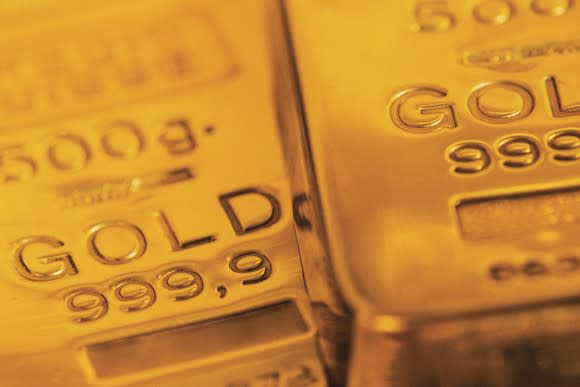1 Warren Buffett "Nugget" of Wisdom I Don't Entirely Agree With
This past weekend, the most anticipated of all annual stockholder meetings kicked off. Roughly 40,000 shareholders of Berkshire Hathaway (NYSE: BRK-A)(NYSE: BRK-B) from across the country descended on Omaha, Nebraska, to hear long-term investment icons Warren Buffett and his right-hand man, Charlie Munger, speak for hours about the stock market, money, and the state of the U.S. economy.
As you can imagine, quite a many things were learned by Berkshire's shareholders this weekend. They found out that Buffett has a growing affinity for tech giant Apple, with Berkshire Hathaway adding about 75 million shares of the stock to its existing position during the first quarter. Investors also learned that Buffett will stick by troubled banking giant Wells Fargo, which is suffering from a crisis of confidence after millions of accounts were opened for customers at the company's physical branches without authorization.
But it was a "nugget" of wisdom from the Oracle of Omaha, with which he opened Berkshire's annual meeting, that caught a lot of attention.

Berkshire Hathaway CEO, Warren Buffett. Image source: The Motley Fool.
Buffett's nugget of wisdom
Buffett began Berkshire's annual meeting by recounting his very first investment back in 1942 -- three shares of oil and gas producer Cities Service Preferred -- and how he jumped the gun by selling those shares for a meager $5.25 gain a few months later. Had he held, he'd have quadrupled his money within four years.
Yet it wasn't just long-term investing Buffett was getting at with this story. He also used this time to compare stocks to a common investment people often flock to during times of uncertainty: gold. And make no mistake about it, just a decade after the Great Depression, the stock market was volatile, and investors' nerves were jittery.
Despite being the go-to investment for fearful traders, Buffett points out that equal $10,000 investments in the S&P 500 and gold in 1942 would be worth a respective $51 million and $400,000 today. Stocks absolutely trounced the return of physical gold. Said Buffett, courtesy of Business Insider:
In other words, for every dollar you could have made in American business, you'd have less than a penny gain by buying into a store of value which people tell you to run to every time you get scared by the headlines.
While the businesses were reinvesting in more plants and new inventions came along, you would ... look into your safety deposit box, and you'd have your 300 ounces of gold. And you would look at it, and you could fondle it, I mean, whatever you wanted to do with it. But it didn't produce anything. It was never going to produce anything. And what would you have today? You would have 300 ounces of gold just like you had in March of 1942, and it would be worth approximately $400,000.

Image source: Getty Images.
Buffett is mostly right about physical gold
In many ways, Buffett's analysis of the shiny yellow metal has merits.
For example, unlike a publicly traded company, there isn't nearly as much data for investors to comb through when it comes to physical gold. Investors can track supply and-demand data on the precious yellow metal, but other than this, and fear, as measured by the CBOE Volatility Index, there aren't too many tangible catalysts that allow for a reasoned investment decision.
Comparably, publicly traded stocks allow an investor to scour through earnings reports, annual statements, CEO commentary, balance sheets, as well as competitors' earnings, commentary, balance sheets, and so on, to make an educated determination on which way a stock will head next.
The other factor to remember here, as Buffett points out, is that gold is an asset, and stocks are a business. Investors have an opportunity to take advantage of the maneuvering of management and the growth of a business over time. They may even be paid a dividend if a company becomes sustainably profitable over an extended period of time.
Meanwhile, physical gold doesn't pay any dividend, and it has no management structure to speak of. Though it does offer scarcity -- i.e., all the gold we'll ever have on this planet has either been mined or is still in the ground -- and demand is only expected to grow as the global population increases, you're still left to cross your fingers and hope that someone else will come along and pay more per ounce in the future than you did.

Image source: Getty Images.
Is Buffett overlooking a source of attractive gains?
However, Buffett's aversion to gold could come at a price. While I agree with the Oracle of Omaha that owning physical gold isn't a particularly intriguing investment, his distaste for the precious metal might lead him to overlook gold-mining stocks, which, in this investor's opinion, are looking more attractive than they have in years.
As an industry, gold-mining companies have worked hard over the past five years to considerably reduce their debt, pare their capital expenditures, and focus on only the highest-yielding mines. We've also witnessed quite a bit of industrywide consolidation, which has further aided cost controls. Considering that spot gold has been above $1,300 an ounce now for more than four months -- its longest such stretch in five years -- gold-mining stocks have the potential to really surprise Wall Street with above-average margins and profitability in the quarters and years to come (assuming gold's spot price remains relatively strong).
How confident am I in precious-metal mining companies? So much so that my two largest portfolio holdings are in mining companies. The largest, by far, being SSR Mining (NASDAQ: SSRM), which is a producer of gold and silver in North and South America.
SSR Mining's flagship asset is the Marigold mine in Nevada, which has the potential for modest organic production expansion over time. In 2016, SSR Mining acquired Claude Resources, giving it access to the Seabee gold mine in Canada. Within Seabee is the Santoy Gap, a high-grade recovery zone that continues to deliver record annual production at a low cost for SSR Mining. Lastly, the company's Puna Operations in Argentina, a respective 75%/25% joint venture with Golden Arrow, is expected to begin commercial production of silver in the second half of this year. Even with this silver production, in the neighborhood of three-quarters of SSR Mining's revenue will likely come from gold production.

Image source: Getty Images.
SSR Mining, like many other gold miners, is relatively cheap on a cash flow per share basis. Why cash flow per share and not earnings per share? Since mining is all about reinvestment -- i.e., being able to pay down debt, buy equipment, fund exploration, and finance expansion -- cash flow is the most important figure in my mind. Throughout years of experience in monitoring the mining industry, I've determined that 10 times cash flow per share seems to be a "fair valuation" for mining stocks. SSR Mining is valued at just 6.7 times next year's cash flow per share, implying that it has an almost 50% upside, based on my valuation model, and assuming that gold's spot price hovers around $1,300 an ounce.
Make no mistake -- there are other attractive deals out there similar to SSR Mining. The point being that ignoring gold mining businesses could be a mistake. Though the Oracle of Omaha has an aversion to the precious yellow metal, I certainly don't and would caution investors against ignoring what could be a very lucrative group of stocks to own over the long run.
More From The Motley Fool
Sean Williams owns shares of SSR Mining Inc. The Motley Fool owns shares of and recommends Apple and Berkshire Hathaway (B shares). The Motley Fool has the following options: long January 2020 $150 calls on Apple and short January 2020 $155 calls on Apple. The Motley Fool has a disclosure policy.
